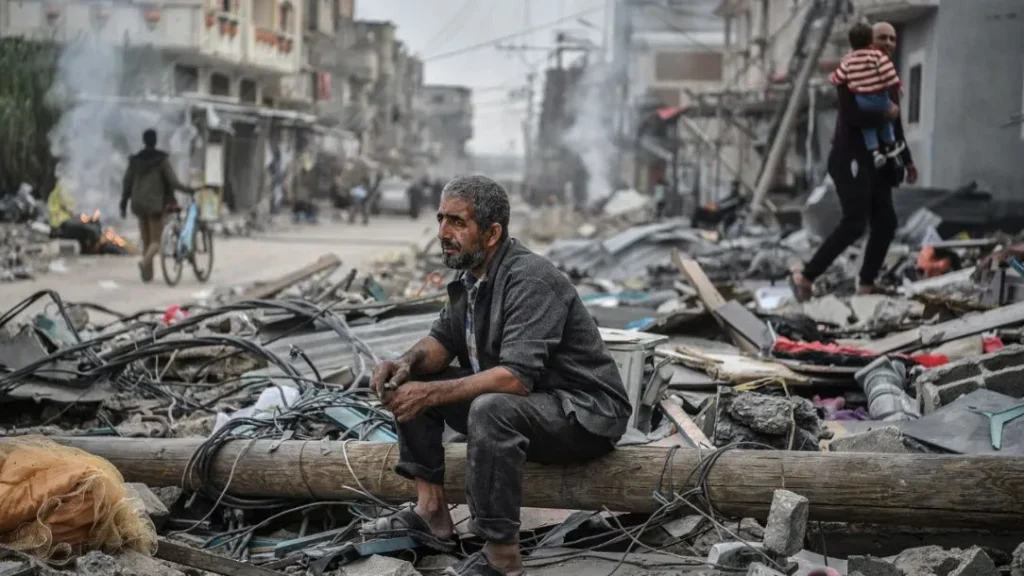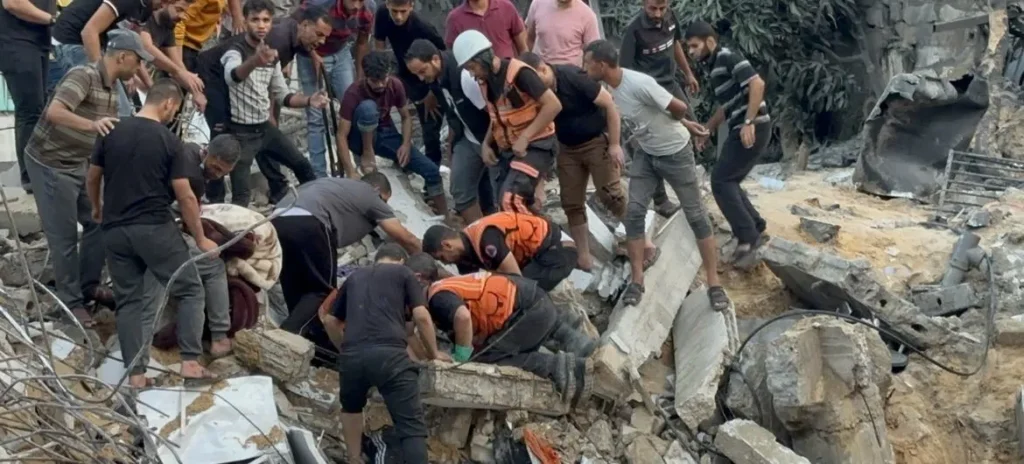In 2025, the Gaza Strip will have become synonymous with humanitarian collapse. Once a densely populated region of political tension and economic blockade, Gaza now faces its worst crisis in decades—a brutal convergence of war, displacement, infrastructure ruin, and mass starvation.
The international community watches as Gaza’s 2.3 million people face a grim reality: no clean water, little electricity, rampant disease, and an uncertain future. While headlines focus on geopolitical conflict, the human cost is unfolding in real-time, with civilians—especially women and children—paying the highest price.
A Region Under Siege
Gaza has long struggled under the weight of political isolation and military confrontation. However, the events of recent years—escalating armed conflict, siege-like conditions, and the collapse of public services—have pushed the enclave into a full-scale humanitarian emergency.
🔒 Blockade and Isolation
Since 2007, Gaza has been under a land, sea, and air blockade, severely limiting the flow of goods, medicine, and people. What began as a security measure has turned into a near-total isolation, leaving hospitals without supplies and residents without hope.
💥 Recurring Violence
Frequent bombardments and armed clashes have devastated homes, schools, and infrastructure. With each cycle of violence, rebuilding becomes more difficult, leaving a trail of trauma and broken systems.

Infrastructure in Ruins
One of the clearest indicators of Gaza’s collapse is its crumbling infrastructure.
⚡ Electricity Blackouts
Residents receive as little as 2–4 hours of electricity per day, disrupting hospitals, water treatment, and communications. Backup generators run dry due to fuel shortages.
💧 Water Crisis
More than 97% of Gaza’s water is undrinkable. Desalination plants are damaged or non-functional, and raw sewage contaminates groundwater supplies. Families rely on sporadic water deliveries, often at exorbitant prices.
🏥 Health System Breakdown
Hospitals operate without anesthesia, antibiotics, or basic medical tools. Thousands of injured civilians go untreated. Doctors perform surgeries under flashlights. The healthcare system is in danger of collapsing completely.
Human Displacement and Shelter Crisis
Over a million Gazans have been displaced from their homes due to the conflict. Shelters are overcrowded, unsanitary, and unsafe. Families without running water or toilets sleep in tents, classrooms, or temporary housing.
- Schools-turned-shelters now hold thousands with no sanitation facilities.
- Entire neighborhoods lie in rubble, with no resources to rebuild.
- Children live in constant psychological distress, lacking education, stability, or safe spaces.
Starvation and Food Insecurity
Famine is no longer a distant risk—it’s already gripping Gaza.
🍞 Food Supplies Cut Off
With farmlands bombed and borders sealed, food is scarce. Markets are empty, and humanitarian aid convoys face barriers or outright bans. Malnutrition has become widespread, particularly among children and the elderly.
⚠️ Children Dying of Hunger
Recent reports confirm dozens of child deaths due to starvation, and thousands more are at critical risk. UNICEF calls it a “man-made famine” born from deliberate denial of access to food and water.
The Psychological Toll
While the physical destruction is evident, the mental and emotional collapse is harder to measure, but no less severe.
- Children exhibit PTSD symptoms, including night terrors, mutism, and aggression.
- Suicide rates are rising, particularly among youth.
- Parents experience guilt and helplessness, unable to protect or provide for their children.
There is no psychological support available to survivors since mental health experts have either gone or lack the necessary equipment.

Aid Blockages and International Paralysis
🚫 Humanitarian Convoys Delayed or Denied
Organizations like the UN, Red Crescent, and Médecins Sans Frontières face mounting barriers to entry. Aid is delayed at checkpoints, destroyed in airstrikes, or denied clearance altogether.
🏛️ Global Diplomacy Gridlocked
World powers remain paralyzed by political allegiances. Resolutions stall at the UN, and calls for ceasefires are routinely ignored. Meanwhile, civilians continue to suffer without protection or accountability.
The Collapse of Civil Services
Even beyond hospitals and shelters, Gaza’s society is falling apart:
- No functioning police force or civil protection
- Waste collection halted, leading to disease outbreaks
- Court systems and civil registry frozen
- Communication networks are disabled, limiting news and external contact
In effect, Gaza is a territory without a functioning state—chaotic, leaderless, and vulnerable to exploitation.
The Role of Media and Information Control
The crisis in Gaza is also a war over narrative.
- Journalists face extreme risk, with multiple press members killed or silenced.
- Internet blackouts and restricted access prevent real-time reporting.
- Disinformation spreads rapidly, fueling division and hampering relief efforts.
As the truth becomes harder to verify, the people of Gaza are losing not just their homes, but their voice.
What Can Be Done?
Despite the catastrophe, hope remains through urgent international action:
✅ 1. Immediate Ceasefire
All parties must agree to an immediate and verifiable ceasefire to allow humanitarian access and prevent further civilian deaths.
✅ 2. Unhindered Aid Access
Aid organizations need secure corridors to deliver food, medicine, and shelter supplies without delay or interference.
✅ 3. Rebuilding Infrastructure
Long-term rebuilding of power grids, hospitals, and water systems must be supported by international funds and engineers.
✅ 4. Psychological Support
Trauma recovery programs—especially for children—must be implemented through trained personnel and safe environments.
✅ 5. Political Dialogue
Only sustained political negotiations can prevent a return to violence. Peace efforts must center on human dignity, not just a power balance.
Global Voices Rising
From protests in world capitals to statements by Nobel laureates and humanitarian leaders, global awareness is growing. The call is clear:
“This is not a political issue—it’s a human one.”
Youth movements, religious organizations, and NGOs are banding together to raise awareness of the suffering of Gaza’s citizens and provide food and financial support.
But without immediate and unified government action, these efforts may not be enough.
Related Blog: Dollar Plunges as Trump Threatens Powell, Markets Waver
Conclusion: A Territory on the Edge of Extinction
In 2025, Gaza is not simply experiencing hardship—it is experiencing humanitarian collapse. This isn’t just a regional crisis. It’s a test of the world’s conscience.
The question is no longer if Gaza will survive the next year—it’s what remains of its people when it does.
Because behind every headline is a mother rationing food, a father digging through rubble, a child dreaming of peace. Their survival depends not on weapons or alliances, but on the world’s collective will to act—before it’s too late.
FAQs: Gaza’s Humanitarian Collapse
Q1: What caused the current crisis in Gaza?
A: A combination of military conflict, longstanding blockades, infrastructure destruction, and restricted humanitarian aid has led to a full-scale humanitarian collapse.
Q2: How many people are affected?
A: Over 2.3 million people live in Gaza, with over half displaced, millions lacking water, and thousands at risk of starvation or untreated illness.
Q3: Is Gaza under blockade?
A: Yes. Since 2007, Gaza has been under a blockade by land, sea, and air, severely restricting food, medical supplies, and the movement of people.
Q4: Why is electricity so limited in Gaza?
A: Power stations have been bombed or lack fuel, providing only 2–4 hours of electricity per day on average.
Q5: Are aid organizations able to operate in Gaza?
A: Many are trying, but access is limited, convoys are often blocked or attacked, and the conditions are dangerous for aid workers.




